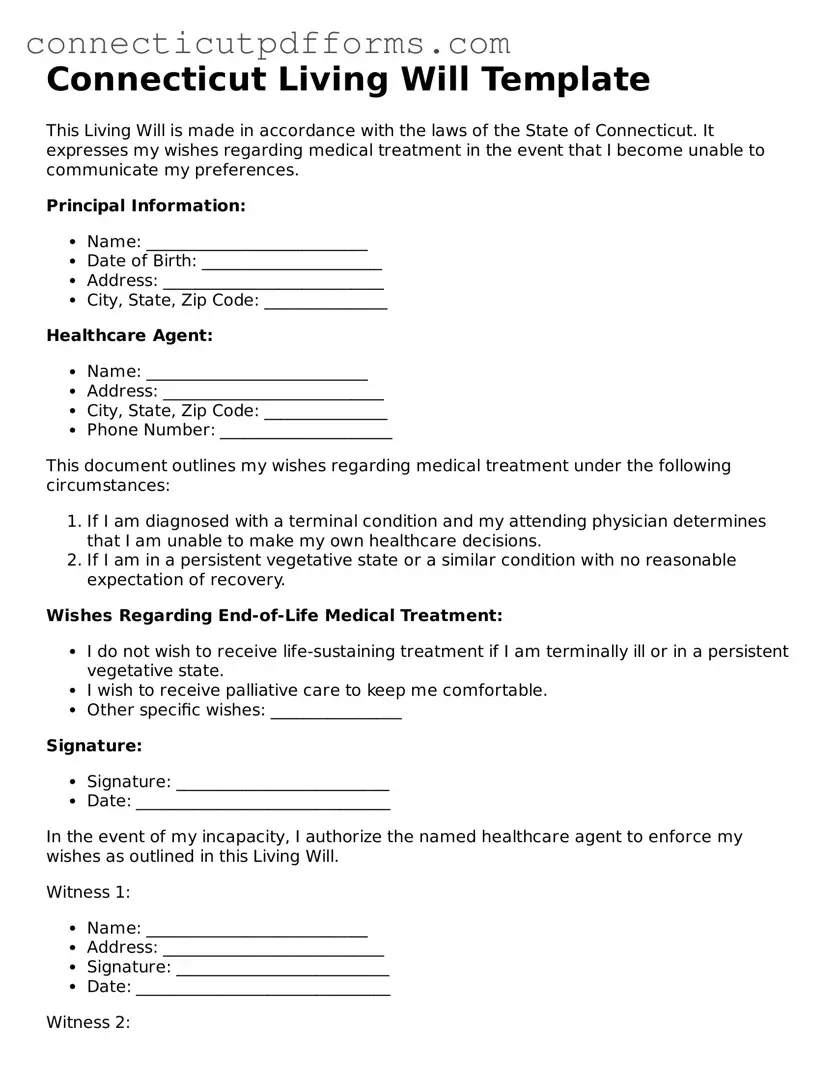The Connecticut Living Will form is similar to the Advance Directive. Both documents serve to outline an individual's wishes regarding medical treatment in case they become unable to communicate their preferences. An Advance Directive can include a Living Will and a Health Care Proxy, allowing individuals to specify their treatment preferences and designate someone to make decisions on their behalf.
Another document similar to the Living Will is the Durable Power of Attorney for Health Care. This document allows a person to appoint an agent to make health care decisions for them if they cannot do so themselves. While a Living Will focuses on specific treatment preferences, the Durable Power of Attorney provides broader authority to the appointed agent to make decisions based on the individual's best interests.
The Do Not Resuscitate (DNR) order is also comparable. A DNR order specifically instructs medical personnel not to perform CPR if a person’s heart stops or they stop breathing. While a Living Will may address a range of medical interventions, a DNR is focused solely on resuscitation efforts in emergencies.
The Physician Orders for Life-Sustaining Treatment (POLST) form shares similarities as well. POLST translates a patient's wishes regarding life-sustaining treatments into actionable medical orders. While a Living Will expresses wishes generally, POLST provides specific medical orders that healthcare providers must follow, making it a more immediate tool in critical situations.
The Health Care Proxy is another related document. This allows individuals to appoint someone to make health care decisions on their behalf. Unlike a Living Will, which details specific treatment preferences, a Health Care Proxy empowers a trusted person to interpret and make choices based on those preferences if the individual is unable to do so.
The Five Wishes document is also relevant. It combines elements of a Living Will and a Health Care Proxy, addressing not just medical preferences but also personal, emotional, and spiritual wishes. This document allows individuals to express their desires regarding care, comfort, and dignity, making it a more holistic approach to end-of-life planning.
The Advance Care Plan is similar, as it encompasses a broader strategy for making health care decisions. It includes discussions about preferences, values, and goals for care, which can inform both a Living Will and a Health Care Proxy. This plan encourages conversations with family and healthcare providers, ensuring that wishes are understood and respected.
The Mental Health Advance Directive is another related document. It allows individuals to outline their preferences for mental health treatment in case they become unable to communicate. Like a Living Will, it focuses on specific wishes but is tailored to mental health scenarios, addressing concerns about treatment and interventions during mental health crises.
For those needing to halt unwanted actions, utilizing a formal document known as a Cease and Desist Letter can be essential. This legal tool allows individuals to formally request that another party discontinue an inappropriate activity. To guide you through the process of taking this important step, you can find a useful resource here: comprehensive guide on Cease and Desist Letter preparation.
Lastly, the Organ Donation form is similar in that it expresses individual wishes regarding organ donation after death. While a Living Will primarily addresses medical treatment preferences during life, the Organ Donation form ensures that an individual's wishes regarding posthumous organ donation are clearly stated and respected.
